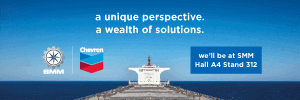A battle to drydock the battleship USS Texas
During the past year Gulf Copper travelled to the Bahamas and purchased a large drydock that had been sunk, broken over its length and cut in half during salvage. Jonathan Hale, Executive Vice President of Gulf Copper & Manufacturing Corp, tells the story of how the battle was won to resurrect it in time to drydock the ‘superdreadnought’ USS Texas – BB35.
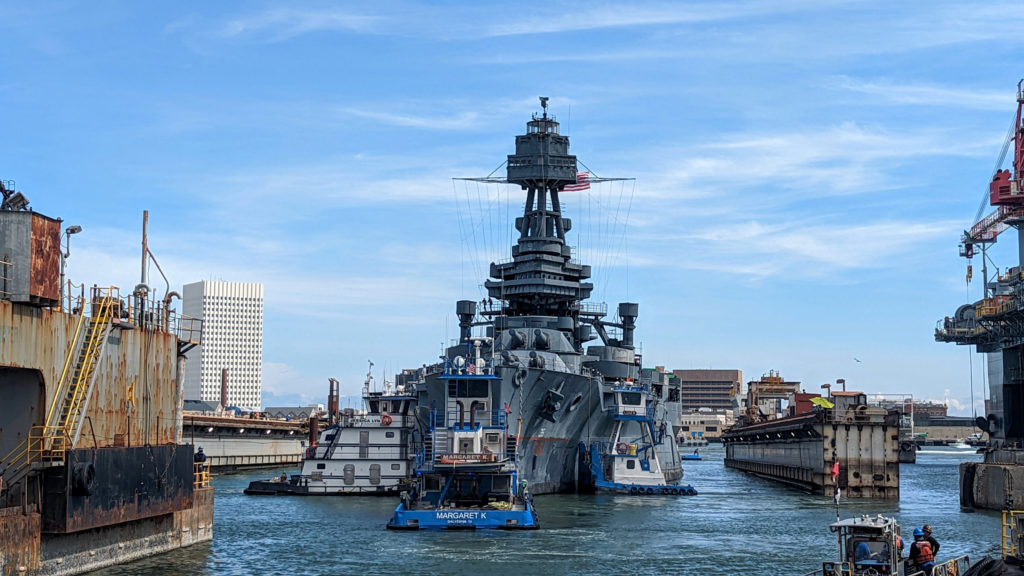
The repaired floating dock with the ‘superdreadnought’ USS Texas being floated in
Commissioned in 1914, the battleship Texas is credited with the introduction and innovation in gunnery, aviation and radar. It is the last surviving dreadnought and the only battleship still in existence that fought in both World War I and World War II.
Q. Did you buy it specifically for this job, or were you already looking at acquiring a larger floating dock?
A. Gulf Copper had been investigating the acquisition of a (pre)Panamax-capable drydock to replace our out-of-service 35,000-ton drydock in Galveston, Texas when the Battleship Texas Foundation (BTF) approached us in 2019 with the request that we move quickly to purchase a dock for their project. The BTF proposed acquisition of a damaged drydock, and provided engineering studies supporting its use for docking the battleship. While the drydock was originally designed for 81,000LT, we ended up with just under half of the original length, which resulted in an estimated design capacity of 39,500LT .
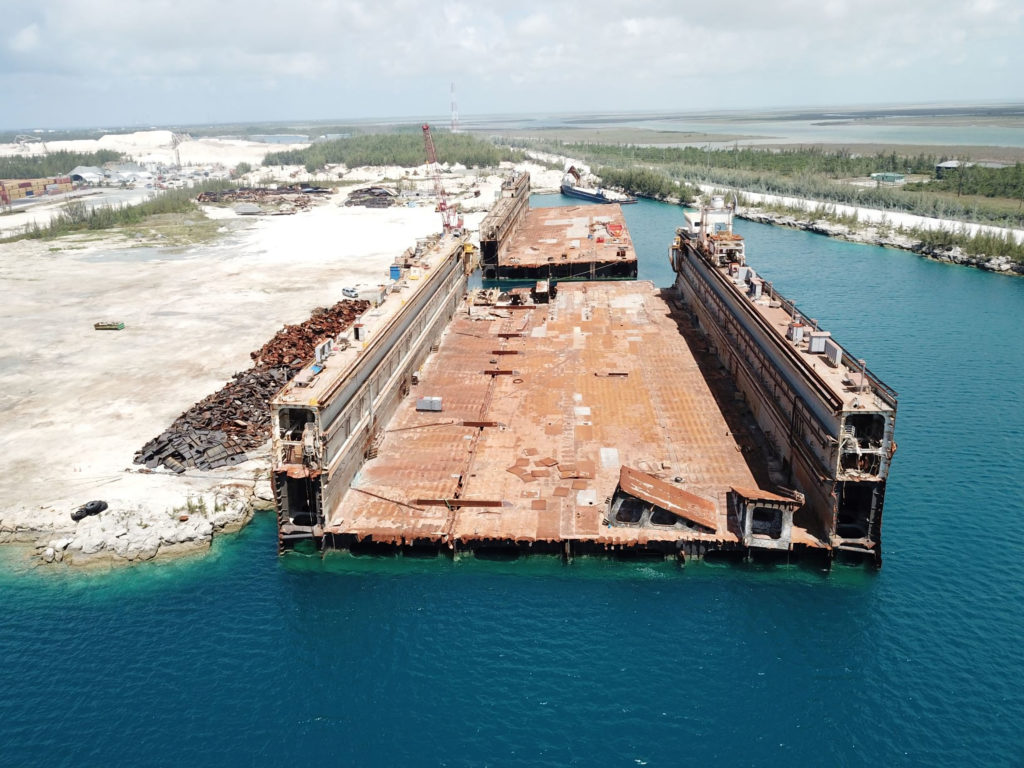
The floating dock as purchased
Q. What made you pick this dock in preference to building your own or acquiring a finished dock elsewhere?
A. After a year-long search, Gulf Copper was unable to locate a reasonably priced dock with the capabilities necessary which could be delivered within BTF’s required timeframe. The damaged drydock was originally offered at an attractive price. Unfortunately, inspection of the dock was delayed until the middle of 2020 due to Covid shutdowns. Arriving on the first available post-Covid flight, we found that the repairs required to put the dock into service for the battleship were much more costly than initially reported. However, the costs to obtain a commercially viable dock upon completion of the Battleship Texas project were even higher.
Q. What condition was the drydock in?
A. The drydock was a 42-year-old unit measuring 902’ (275m) x 228’ (69.5m) with a 22’ (6.7m) pontoon depth and 198’ (60.35m) between walls. It had endured a catastrophic failure over its entire length just outboard of the port intermediate longitudinal bulkhead. A similar partial failure occurred over a portion of the starboard side. The salvor had scuttled the dock, cut it transversely between frames 41 and 42, and re-floated both halves. Several areas of associated damage existed around the deck and wing walls. We also had to deal with many salvage openings and closures. The dock was presented afloat with a five-degree distortion resulting in the port outboard bottom plating being upset by 38 inches (approximately 1m) and the port wing wall being set inboard by several feet. Additional issues to deal with were the condition of the dewatering pumps, destroyed electrical/control systems, and wasted deck plating.
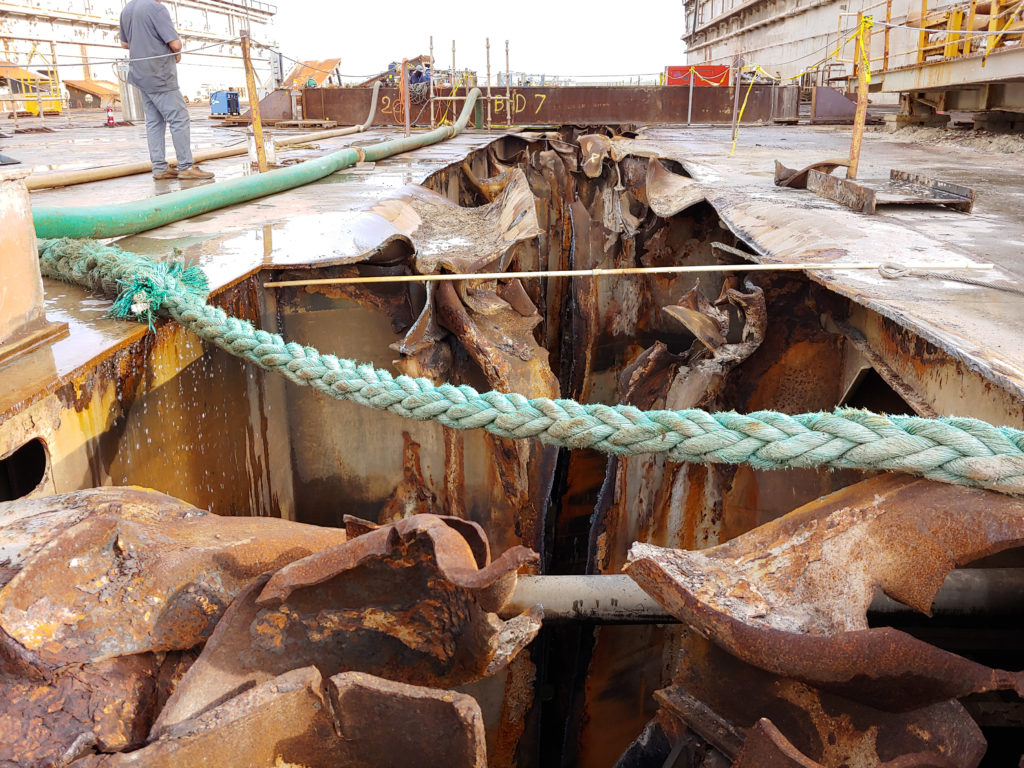
The catastrophic damage on the port side
Q. Did you carry out the work in the Bahamas, or did Grand Bahama Shipyard do it?
A. Gulf Copper’s inspection team arrived at Freeport, Bahamas on the first available post-Covid flight and found that the repairs required to put the dock into service for the battleship were much more costly than initially reported. Several trips were made for detailed evaluation of the damage, proposed repairs and costing. During each visit, local contractors and vendors were interviewed. Thousands of contacts were made for needed services, supplies, materials, labour, and logistics. There were several repair plans developed with separate costing scheduling and risk analyses. We accounted for all known issues as well as accommodation for unknowns. We re-evaluated all studies and technical information provided by owners, and developed a realignment plan and steel renewal plan. We completely redesigned the electrical and control systems.
Q. How was the project managed?
A. The project was managed by Dave Casale, one of Gulf Copper’s Galveston Project Managers, and several of our US-based repair superintendents. We hired a local consultant, Mark Wilson, who we credit with the success of the Freeport portion of the project. Logistics and staffing were managed out of our Gulf Copper Galveston Facility. Design and engineering services were provided by Sealy Technical Services. The electrical system was designed, installed and commissioned by our Gulf Copper Energy Services electrical group. We mobilised a team of steel workers from our Gulf Copper Mexican operations in Ciudad del Carmen as well as hiring a substantial team of local labour in Freeport.
A local HSE consultant was engaged to provide a safety programme meeting both our in-house requirements as well as Bahamian best practices. The latest generation of ballast controls were designed and installed by Bergan Marine Systems of Florida.
Q. How was the realignment carried out?
A. In order to repair the major damages, we first installed 12 heavy beams across the damaged pontoon deck. They were attached with stops in either direction to prevent over/under adjustment during the alignment process. We then installed additional salvage closures and removed some closures in various bulkheads to give us the ability to ballast as needed. Seven stations were set up with markings on the port wing wall to visually align the pontoon deck relative to the bottom shell using a standard transit. The damaged transverse framing was released from a point 30 inches (0.76m) above bottom to the deck with only the end bulkheads remaining intact up to 72 inches (1.8m). A small round hole was drilled at the bottom of each cut, and reinforcing flat bar welded immediately below the hole to prevent propagation below the waterline. Finally, the dock was de-ballasted as per plan and the dock was realigned in a matter of hours after several weeks of preparation. The alignment beams were welded in place for support during the repair process.
Q. What additional repairs were carried out in the Bahamas?
A. All the framing was rough cut to within 8 inches (0.2m) of the bottom plating. We found that the original plating flattened out to within a quarter inch (6.3mm), allowing us to install a flat bar bracket as a foundation for the newly-inserted plate. We then installed 5/8 inch (15.9mm) plating with over scantling stiffeners at each frame and bulkhead. Deck plating with underdeck stiffening was then prefabricated in panels and installed in large sections.
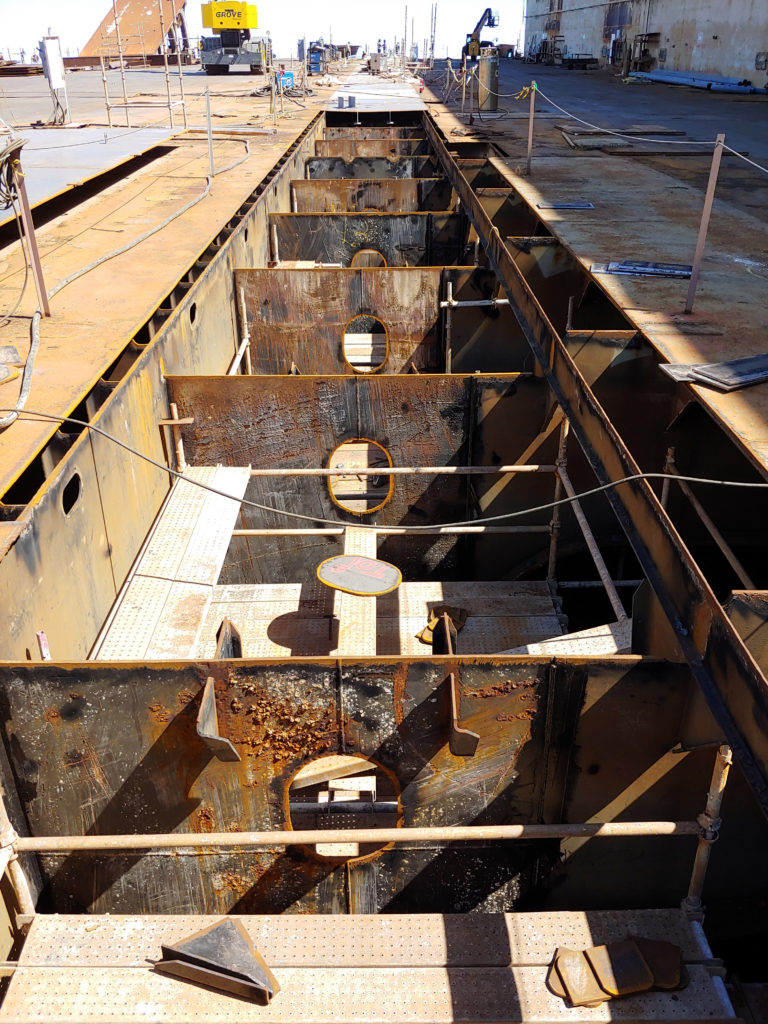
New framing in way of the damage
On the starboard side, we removed the deck plating and cropped only small distorted sections of framing with no realignment required. After conferring with our naval architect, we cropped the pontoon plating back to within 4 inches (100mm) of frame 41. We then added all new internal vertical stiffening and only inserted the openings in the frame required to create a new transom bulkhead.
We inserted approximately 40 salvage openings and removed 60 temporary closures while in the Bahamas.
Other repairs included all new cabling, lighting and ventilation, new switchboards, transformers and load centres. We also repaired the motor controllers, ballast control system, valve actuators, and carried out a complete overhaul of all dewatering pumps, adding new pump motors, and manholes/access closures.
Finally, preparations for tow were made, including fitting a main towing bridle, emergency pumping, towing and anchoring systems and navigation fittings. All the loose items were secured, and trimming the dock was carried out under the very experienced direction of John Waite of Marine Investigations & Survey Services Ltd. The Signet Warhorse II was chartered for the thousand-mile trip to Galveston.
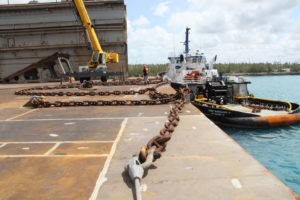
The towing vessel making the connection
Q. What would you say were the biggest challenges?
A. Even with the countless hours of planning, Covid-affected logistics presented significant issues. We received the finest assistance from the professionals at National Shipping and Seacor Island Lines. Mobilising any team over distance is fraught with dangers, especially in the middle of a pandemic. By moving the team on a chartered jet, we avoided countless problems.
Regulatory issues presented substantial challenges, as the title of the dock was in question for over half the duration of the project. Our in-house attorney and a small team of lawyers were busy for several months untangling the mess. Organising the numerous inspections for the re-registry of the dock, underwriters and bankers required a deep pool of knowledge, research and anticipation of requirements not always made clear.
Q. What additional work was required back at Gulf Copper before drydocking USS Texas?
A. Once the drydock was in Galveston, new docking blocks were fabricated, and final preparations of the berth were made, testing all the drydock systems. Several ‘dry runs’ were conducted prior to towing the Battleship Texas to Galveston. The drydock was submerged and ready for the battleship as it was towed into Galveston Harbour. The actual drydocking was undertaken without incident, and repairs to the legendary ship were underway the next day.

The actual drydocking was undertaken without incident
Q. How is the work on the USS Texas progressing and when do you think it will be completed?
A. The Battleship Texas job has progressed nicely. Removal of temporary foam flotation was tedious, but the removal contractor made good progress with high pressure blasting. Gulf Copper prefabricated most of the replacement torpedo blister tanks, with only the extreme forward and aft tapered sections being built in place.
Substantial internal structural and renewal/doubling of the original hull plating is required due to excessive corrosion. Gulf Copper expects to complete all underwater hull work by this summer. The vessel will be re-floated, and a substantial amount of topside repairs are anticipated once the ship is afloat alongside.
Q. Do you have other drydockings planned after the USS Texas?
A. We are receiving a number of drydocking enquiries for the new (to us) Galveston drydock and will be offering in this capacity when the Battleship Texas launch date is determined.
Jonathan Hale has been in the Maritime Business for over 50 years, beginning as a hand on his father’s small tug whilst in high school.

Jonathan Hale, Executive Vice President of Gulf Copper & Manufacturing Corp
After obtaining an engineering degree at the US Merchant Marine Academy, he has worked in almost all areas of the business. Starting as a seagoing Marine Engineer and moving ashore as a Marine Surveyor, he established a sound base of practical knowledge. He then moved into management positions with various shipowners and offshore floating production companies. Developing an interest in maintenance and repair of these valuable assets, he started a small marine equipment repair business in Houston, Texas. After joining his brothers at Gulf Copper in 2002, Hale took on assignments in all aspects of the ship repair business including management of all commercial repair yards, government services division, new venture development and capital projects. He oversees Gulf Copper operations in Galveston, Port Arthur, Corpus Christi, San Diego, and Guam.
Together with his brother Steve, they have purchased a total of seven pre-owned drydocks and relocated them to Gulf Copper Facilities. Three of those have required major overhauls or conversion.
If you enjoyed this article check out the rest of DryDock magazine
Or how about Maintaining HMS Victory






